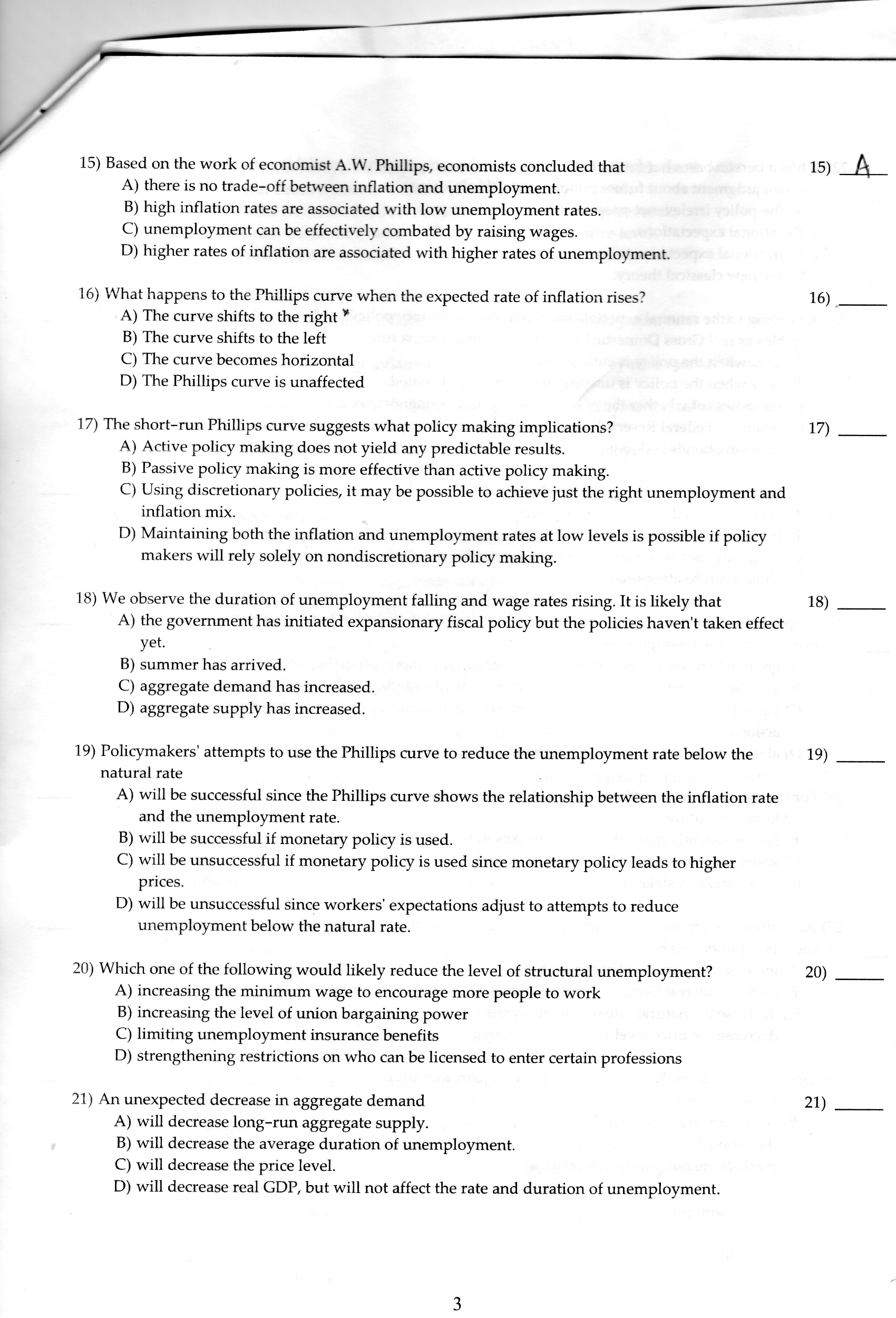O the level of unemployment and inflation A recession in foreign countries will Select one. O unemployment and income equality.
Phillips found an inverse relationship between the level of unemployment and the rate of change in wages ie wage inflation.

. Lower unemployment could be simply achieved by printing more money and increasing inflation. Economic growth and full employment Oc price level stability and income equality. Full employment and income equality D.
Why might falling unemployment. Full employment and price level stability. A contractionary stabilisation policy moves the economy down from right to left from point E to E along the SRAS curve in Fig.
Aggregate Supply Unemployment And Inflation. Their common enemy is the Phillips Curve an old economic theory that guides monetary policy and suggests there must be a trade-off. The long-run upward-sloping aggregate demand curve implies an upward-sloping Phillips curve.
Deconomic growth and full employment. The traditional Phillips Curve suggests a trade-off between. Phillips who examined UK.
In the 1950s and early-to-mid 1960s the Phillips curve tended to hold. Economic growth and full employment. The Phillips curve shows the trade-off between _____ and _____.
The traditional Phillips Curve suggests a tradeoff between. The original Phillips Curve suggests a trade off between A inflation and from MACRO 1010 at York University. It follows then that in the long run there is no trade-off.
Which statement concerning the tradeoff between financing through debt or equity is true. The Phillips curve is named after economist AW. The long-run Phillips curve is a vertical line that illustrates that there is no permanent trade-off between inflation and unemployment in the long run.
The traditional Phillips curve suggests a conflict or tradeoff between. Economic growth and full employment E. The traditional Phillips Curve suggests a trade-off between Multiple Choice preability and income equality the level of unemployment and Inflation.
Asked Aug 8 2019 in Economics by Skank01. O a the level of unemployment and price level stability O b. Is depicted by the long-run Phillips curve.
135 causing unemployment to rise but the annual inflation rate to fall. There is a short run trade off between unemployment and inflation. Price level stability and income equality B.
The Phillips Curve suggests a tradeoff between. Phillips curve is know as the trade-off between inflation rate and unemployment rate. Thus there is a trade-off between inflation and unemployment.
A price stability and income equality. In 1958 he used the previous 95 years of economic data to suggest that there exists a trade off between unemployment and inflation. C unemployment and income equality.
As unemployment rates increase inflation decreases. The inflation rate interest rates. Only ii is correct.
Aprice stability and income equality. D economic growth and full employment. Lower unemployment comes at the expense of higher inflationary pressure on the economy.
The traditional Phillips Curve suggests a trade-off between. Thus there is a tradeoff between inflation and unemployment in the short run when it comes to government policy. Economic growth and income equality C.
This trade-off between inflation and unemployment rate is explained by Phillips curve. Is consistent with the theory of money neutrality. The inverse relation between inflation and unemploymentor the trade-off between the twois called the Phillips curve.
O economic growth and full employment. Full employment and price level stability. The Phillips curve shows the trade-off between _____ and _____.
This trade-off is the so-called Phillips curve relationship. The basic problem portrayed by the traditional phillips curve is. The Phillips curve tradeoff implies.
The inflation rate the unemployment rate. However the short-run Phillips curve is roughly L-shaped to reflect the initial inverse relationship between the two variables. Since in the long run expected inflation matches with the actual inflation the long run Phillips Curve LRPC becomes vertical at the natural rate of unemployment.
The Phillips curve explains the short run trade-off between inflation and unemployment. A rightward shift of the traditional phillips curve would suggest that. The traditional Phillips Curve suggests a trade-off between.
B the level of unemployment and inflation. For example if unemployment was high and inflation low policymakers could stimulate aggregate demand. Bthe level of unemployment and inflation.
The Phillips curve suggests there is an inverse relationship between inflation and unemployment. Od unemployment and income equality. This finding which became known as the Phillips curve offered a simple trade-off for economic policy makers in the UK and across the world.
O price level stability and income equality. When the unemployment rate is high the inflation rate will be low and. The traditional phillips curve suggests a trade-off between.
Decrease imports of the United States. Shows the possible effects of monetary policy in the short-run. As peoples expectations regarding future price level changes short run Phillips Curve shifts upwards showing trade-offs between inflation and unemployment.
The basic problem portrayed by the traditional phillips curve is. Unemployment and wages from 1861-1957. Cunemployment and income equality.
Unemployment and Income equality. The trade-off between inflation and unemployment. Why does the SR Phillips curve suggest a tradeoff between unemployment and inflation targets.
Why Is There A Trade Off Between Unemployment And Unanticipated Inflation In A Short Run Quora
Why Is There A Trade Off Between Unemployment And Unanticipated Inflation In A Short Run Quora

Solved 15 Based On The Work Of Economist A W Phillips Chegg Com

0 Comments